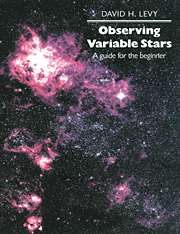Book contents
- Front Matter
- Contents
- Foreword
- Opening thoughts
- Acknowledgments
- Part 1 Getting to know the sky
- Part 2 Getting to know the variables
- 5 Meeting the family
- 6 Getting started with Cepheids
- 7 Algol, the demon of autumn
- 8 How to estimate a variable
- 9 Names and records
- 10 Observing hints
- 11 Stately and wonderful
- 12 Stars of challenge
- 13 Bright, easy, and interesting
- 14 Betelgeuse: easy and hard
- 15 Not too regular
- 16 Nova? What Nova?
- 17 Supernovae
- 18 Three stars for all seasons
- 19 A nova in reverse?
- 20 RU Lupi?
- 21 Orion, the star factory
- 22 Other variable things
- 23 The Sun
- Part 3 Suggested variables for observation throughout the year
- Part 4 A miscellany
- Index
10 - Observing hints
Published online by Cambridge University Press: 22 September 2009
- Front Matter
- Contents
- Foreword
- Opening thoughts
- Acknowledgments
- Part 1 Getting to know the sky
- Part 2 Getting to know the variables
- 5 Meeting the family
- 6 Getting started with Cepheids
- 7 Algol, the demon of autumn
- 8 How to estimate a variable
- 9 Names and records
- 10 Observing hints
- 11 Stately and wonderful
- 12 Stars of challenge
- 13 Bright, easy, and interesting
- 14 Betelgeuse: easy and hard
- 15 Not too regular
- 16 Nova? What Nova?
- 17 Supernovae
- 18 Three stars for all seasons
- 19 A nova in reverse?
- 20 RU Lupi?
- 21 Orion, the star factory
- 22 Other variable things
- 23 The Sun
- Part 3 Suggested variables for observation throughout the year
- Part 4 A miscellany
- Index
Summary
While variable star observing is a specialized branch of observational astronomy, the basic procedures of patience and care that apply to all observing also work with variables.
Plan your program in advance, but be flexible, since the sky often offers surprises. Choose your variable carefully. Is the star likely to be visible through your telescope, or is it obviously too faint? At the other extreme, is your star so bright that observing it is a waste of your precious telescope time?
Telescope
Telescope size
This is more of a consideration than most observers realize. In a sense, each variable star has its own best combination of telescope and eyepiece. The general rule is to use only enough power and magnification to see the variable clearly but not have it so bright that it is hard to estimate. Ideally, the variable should be about two magnitudes brighter than the faintest star you can see with your telescope. If it is much fainter than that, you will have a problem of perceiving the star, and if the variable is several magnitudes brighter, so many photons will enter your eye that its sensitivity to subtle magnitude variations will be affected.
At minimum, a star might be fair game for most telescopes smaller than 30 cm (12 inches), but as the star brightens you could use a smaller telescope. (When discussing a telescope size, I refer to the size of the mirror or objective lens.)
- Type
- Chapter
- Information
- Observing Variable StarsA Guide for the Beginner, pp. 37 - 43Publisher: Cambridge University PressPrint publication year: 1989

